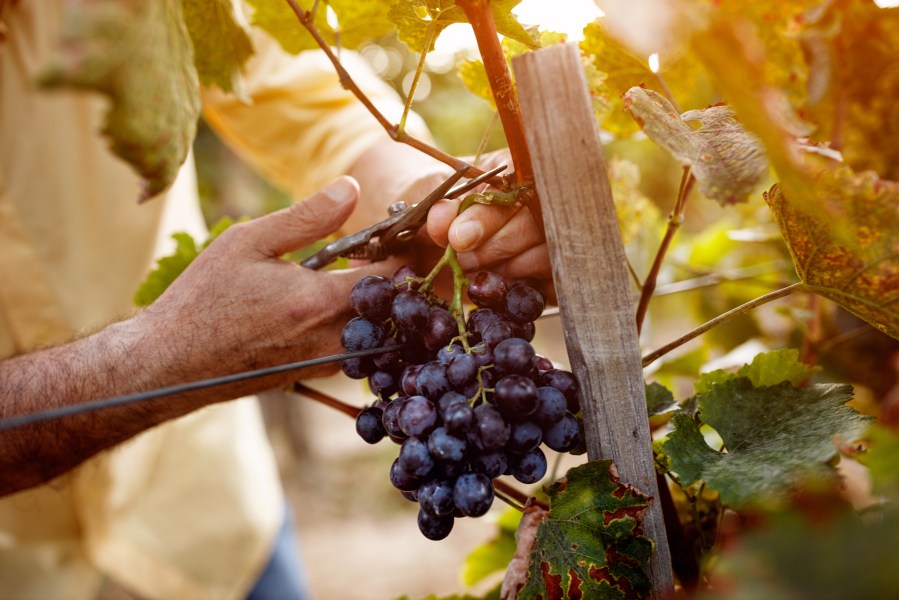With picking of some of the earliest cultivars likely to begin in just a couple of weeks’ time, Rob Saunders and Chris Cooper of Hutchinsons look at how to make the most of this year’s crop.
The 2022 season has been a relatively good one thus far, with excellent conditions throughout flowering helping to build the potential for some decent, potentially bumper, crops.
We may not be looking at a 2018 vintage, but hopefully the weather will be kind over the next couple of months to ensure growers can capitalise on this encouraging potential, in what also promises to be a relatively early start to picking following the hot, dry conditions through June and July.
Early cultivars such as Siegerebbe, Solaris and Rondo were all colouring nicely at the time of writing, with picking expected to begin in the first week of September on the earliest sites. That is some three weeks ahead of the wetter and rather gloomier summer of 2021, and a few days earlier than the 5-10 year average. There is of course a range of maturities to consider, with some Bacchus due to be ready in mid-September, and picking of later-maturing Chardonnay not likely to start until October.
To thin or not?
Late August is typically a time when many growers will be evaluating crop load and thinning bunches to avoid over-cropping and improve the ripening and quality of those on the vine.
However, research presented at the recent International Cool Climate Wine Symposium cast some uncertainty about the effectiveness of this approach. In one trial, removing a deliberately high 50% of the crop load had no effect on quality or maturity. Other work looking specifically at the impact of removing grapes on non-structural carbohydrate in the plant stem, found that only removing grapes after veraison had any impact on sugar transfer.
There may well be occasions where thinning is necessary, such as where there is a particularly heavy crop developing late in the year, less well established root systems in newly planted vineyards, or weak canopy growth, but if this is the case, the research suggests it is better done after veraison, not before.
Whether thinning or not, it is important to manage canopies well to maintain the optimum leaf-to-bunch ratio of 15:1, to ensure leaves can keep feeding the maturing bunches, while also allowing adequate exposure to sunlight for ripening.
Vines must also be kept disease-free and fed appropriately. Tissue testing of leaf blades collected at veraison can be useful for identifying potential deficiencies that need rectifying. Alternatively, you could look back at previous soil tests to see which nutrients might still be lacking.
Potassium (applied in potassium sulphate form) is particularly useful for supporting Brix levels, while some research shows molybdenum has a role in the mobilisation and accumulation of sugars in grapes. There is a range of nutritional products available for late season use, so talk to your agronomist about the most appropriate options.
Protecting vines
With stomatal pores closing as grapes begin to colour the risk from Downy Mildew bunch infection generally reduces – providing of course, canopy management is correct and disease has been well controlled to this point.
It is still worth guarding against mildew infection though. Research shows that foliar nutrition products such as Zynergy (containing copper, zinc and sulphur) and phosphites, such as Phorce, can boost the vine’s natural defence mechanism, markedly reducing Downy Mildew risk.
Of the conventional fungicides, proquinazid offers the strongest and most persistent Powdery Mildew activity, so will provide useful and sustained protection in the run up to harvest but there are harvest interval implications based on product choice.
Generally though, the focus is on botrytis, the risk of which will be increased if the weather during August and September is unsettled, and bunches are tight.
Many traditional botryticides have a 21-28 day harvest interval, however there are various biological alternatives that offer application windows much closer to harvest, such as Vintec, Amylo-X or Serenade.
Given the generally earlier season and warm weather, the risks from Spotted Wing Drosophila (SWD) and wasps are higher this year, so growers should maintain effective precision trap monitoring. Wasps in particular seem to be very prevalent this year and can devastate early ripening, thin skinned grape varieties.
SWD is less common, but if you have had a problem in the past, chances are, there will be one again. Even if SWD has not been seen before, trap monitoring around the edge of vineyards is still useful to assess the risk, although some skill is needed to identify individual species. As always, good vineyard hygiene around picking will help reduce pest and disease risks.




